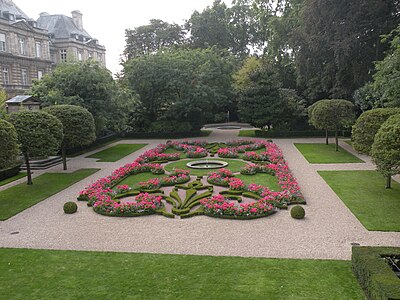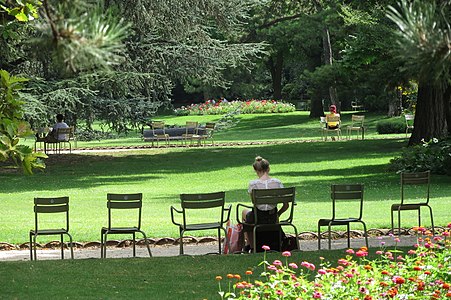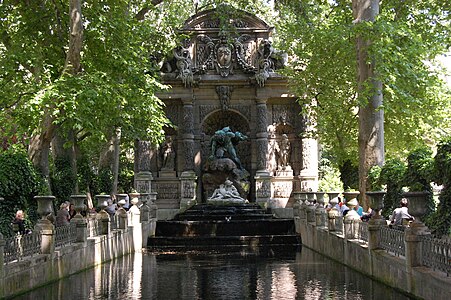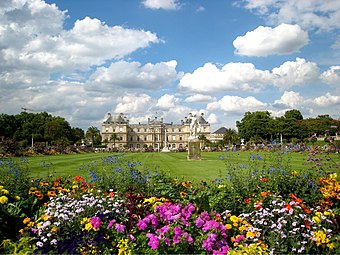Jardin du Luxembourg

The Jardin du Luxembourg (French pronunciation: [ʒaʁdɛ̃ dy lyksɑ̃buʁ]), known in English as the Luxembourg Garden, colloquially referred to as the Jardin du Sénat (Senate Garden), is located in the 6th arrondissement of Paris, France. The creation of the garden began in 1612 when Marie de' Medici, the widow of King Henry IV, constructed the Luxembourg Palace as her new residence. The garden today is owned by the French Senate, which meets in the Palace. It covers 23 hectares (56.8 acres) and is known for its lawns, tree-lined promenades, tennis courts, flowerbeds, model sailboats on its octagonal Grand Bassin, as well as picturesque Medici Fountain, built in 1620.[1] The name Luxembourg comes from the Latin Mons Lucotitius, the name of the hill where the garden is located.[2]
History
In 1611,
In 1630 she bought additional land and enlarged the garden to thirty hectares, and entrusted the work to
-
Garden of the Petit Luxembourg
-
A view of the Luxembourg Garden
-
Model sailboats on the Grand Bassin, similar to those found in the Tuileries Garden
Later monarchs largely neglected the garden. In 1780, the Comte de Provence, the future
During and after the July Monarchy of 1848, the park became the home of a large population of statues; first the Queens and famous women of France, lined along the terraces; then, in 1880s and 1890s, monuments to writers and artists, a small-scale model by Bartholdi of his Liberty Enlightening the World (commonly known as the Statue of Liberty) and one modern sculpture by Zadkine.
In 1865, during the reconstruction of Paris by

During this reconstruction, the chief architect of parks and promenades of Paris,
The garden in the late nineteenth century contained a marionette theater, a music kiosk, greenhouses, an apiary (or bee-house); an orangerie also used for displaying sculpture and modern art (used until the 1930s); a rose garden, the fruit orchard, and about seventy works of sculpture.[5]
Features


The garden is largely devoted to a green
The
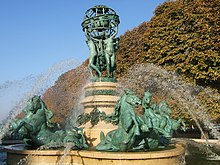
The central axis of the garden is extended, beyond its wrought iron grill and gates opening to rue Auguste Comte, by the central esplanade of the rue de l'Observatoire, officially the Jardin Marco Polo, where sculptures of the four Times of Day alternate with columns and culminate at the southern end with the 1874 "Fountain of the Observatory", also known as the "Fontaine des Quatre-Parties-du-Monde" or the "Carpeaux Fountain", for its sculptures by Jean-Baptiste Carpeaux. It was installed as part of the development of the avenue de l'Observatoire by Gabriel Davioud in 1867.
The bronze fountain represents the work of four sculptors: Louis Vuillemot carved the garlands and festoons around the pedestal,
Open hours for the Luxembourg Garden depend on the month: opening between 7:30 and 8:15 am; closing at dusk between 4:45 and 9:45 pm.
Statuary
The garden contains just over a hundred statues, monuments, and fountains, scattered throughout the grounds. Surrounding the central green space are twenty figures of
.Other sculpted work includes:
- Pierre Guillaume Frédéric le Play, by André-Joseph Allar, 1906
- Liberty Enlightening the World, commonly known as the Frédéric Bartholdi, 1870
- La Bocca della Verità, by Jules Blanchard
- Ludwig van Beethoven, by Antoine Bourdelle, placed here 1978
- Monument to Henri Murger, by Théophile-Henri Bouillon, 1895
- multiple animal sculptures by Auguste Cain
- Le Triomphe de Silène, 1885, Hommage to Delacroix, 1890, and Monument to Auguste Scheurer-Kestner, 1908, both by Jules Dalou
- Monument to Jean-Antoine Watteau, by Henri Désiré Gauquié, 1896
- Narcissus, 1869, and Arion assis sur un dauphin, 1870, both by Ernest-Eugène Hiolle
- Hippomenes by Jean Antoine Injalbert
- Bust of Charles Baudelaire, by Pierre Félix Masseau
- Polyphemus Surprising Acis and Galatea, the Fontaine Médicis, by Auguste Ottin, 1866
- Clémence Isaure by Antoine-Augustin Préault
- Theseus and the Minotaur, by Etienne-Jules Ramey, 1826
- Hercules Diverting the River Alpheus, 1900, and L'Effort, 1902, both by Pierre Roche
- Paul Verlaine, by Rodo (Auguste de Niederhäusern), 1911
- Monument to Édouard Branly, by Charles Marie Louis Joseph Sarrabezolles
- George Sand, by François-Léon Sicard, 1904
- Jules Massenet, by Raoul Verlet, 1926
- Marshal Ney, by François Rude (sculptor) and Alphonse de Gisors (pedestal), 1853.
Medici Fountain
The
-
The Medici Fountain (1630, 1866
-
A closeup of the Fontaine de Medicis, Jardin du Luxembourg, Paris.
-
Fontaine de Léda, (1807), hidden behind the Medici Fountain
Hidden behind the Medici Fountain is the
In popular culture
The gardens are featured prominently in Victor Hugo's novel Les Misérables. It is here that the principal love story of the novel unfolds, as the characters Marius Pontmercy and Cosette first meet. Several scenes of André Gide's novel The Counterfeiters also take place in the gardens.
Henry James also uses the gardens, in The Ambassadors, as the place in which his character Lambert Strether has an epiphany about his identity. The final scene of William Faulkner's novel Sanctuary is set in the gardens. Patrick Modiano heard the news he had won the 2014 Nobel Prize in Literature via a mobile phone call from his daughter while he was walking through Paris "just next to the Jardin du Luxembourg".[11]
Non-literary references include as the setting for a few episodes of French in Action, the 10th Joe Dassin's 1976 studio album Le Jardin du Luxembourg, the cover of Tame Impala's 2012 album Lonerism, the title of a song by the band The Ghost of a Saber Tooth Tiger and the gardens and palace being added as a mission in the video game Assassin's Creed Unity.
Images
-
Gardens in front of the Palais du Luxembourg
-
Panoramic view of the Jardin du Luxembourg
-
Marie de Médicis' fountain, now with Polyphemus SurprisingAcis and Galatea, by Auguste Ottin(1866)
-
Borders of annuals in August
-
A version of the Arrotino under a beech
-
Fontaine de l'Observatoire, at southern end
-
Original model of Liberty Enlightening the World, commonly known as the Statue of Liberty
-
Statue of Gustave Flaubert by Auguste Clésinger
-
The Pool in front of the Palais de Luxembourg
-
View through the gates on Rue Auguste Compte
See also
References
- ^ Jarrasse, Dominique, Grammaire des jardins Parisiens, p. 65-70
- ^ "Luxembourg Gardens, romance in Paris". Paris Digest. 2018. Retrieved 14 October 2018.
- ^ Dominique Jarrassé, Grammaire des Jardins Parisiens, Parigramme, Paris, 2007, pg. 65
- ^ Jarrassé, pg. 66.
- ^ Jarrassé, pg. 68.
- ^ Plan of the Gardens, identifying sculptures Archived 28 February 2009 at the Wayback Machine.
- ^ Sergey Kadinsky (2016). Hidden Waters of New York City: A History and Guide to 101 Forgotten Lakes, Ponds, Creeks, and Streams in the Five Boroughs
- ^ Dorling Kindersley (2012). Eyewitness Travel Family Guide New York City
- ^ Paris et ses fontaines, de la Renaissance à nos jours, texts assembled by Dominque Massounie, Pauline-Prevost-Marcilhacy and Daniel Rabreau, Délegation a l'action artistique de la Ville de Paris, and Yves-Marie Allain and Janine Christiany, L'art des jardins en Europe, Citadelles & Mazenod, Paris, 2006.
- ^ Katia Frey, L'enterprise napoleonienne, p. 115 in Paris et ses Fontaines.
- ^ "Interview with Patrick Modiano". Nobelprize. Retrieved 9 October 2014.
Bibliography
- André Arnold-Peltier and Vassili Karist, Le Jardin du Luxembourg / The Luxembourg gardens, Éditions Pippa, collection Itinérances (ISBN 2-916506-00-4) (photos)
- Paris et ses fontaines, de la Renaissance à nos jours, texts assembled by Dominque Massounie, Pauline-Prevost-Marcilhacy and Daniel Rabreau, Délegation a l'action artistique de la Ville de Paris. from the Collection Paris et son Patrimoine, directed by Beatrice de Andia. Paris, 1995.
- Dominique Jarrassé, Grammaire des Jardins Parisiens, Parigramme, Paris, 2007. (ISBN 978-2-84096-476-6)
External links
- The Luxembourg Gardens page at the Project for Public Spaces
- The Jardin du Luxembourg - Current and old photographs of the garden, statues, fountains
- Info and Jardin du Luxembourg Walk
- The Luxembourg Gardens at Twilight - One of a series of paintings featuring the gardens by American (b. Italy) artist John Singer Sargent
- Webpages about the Garden (in French)

